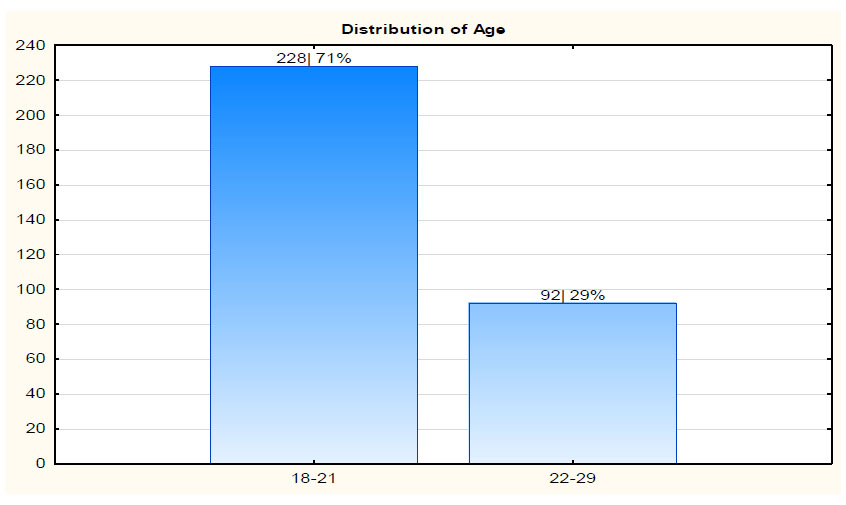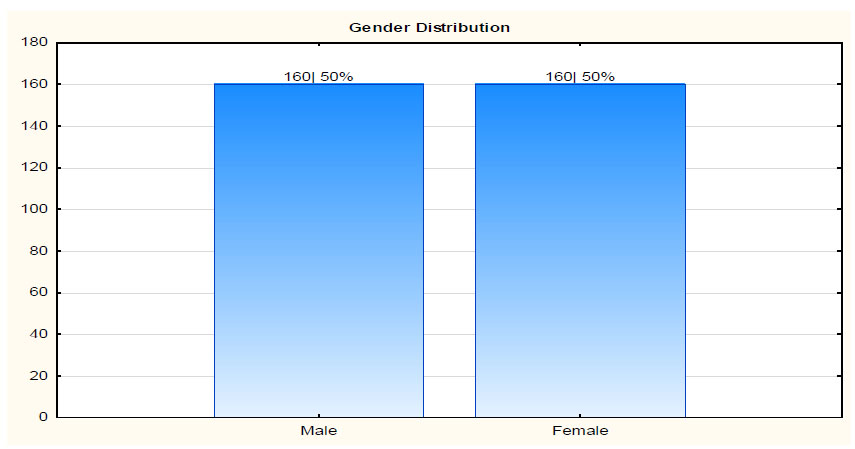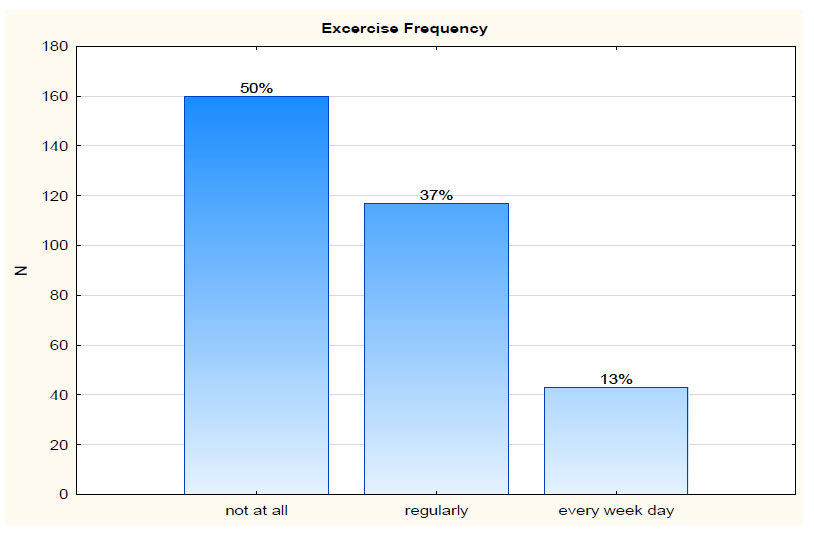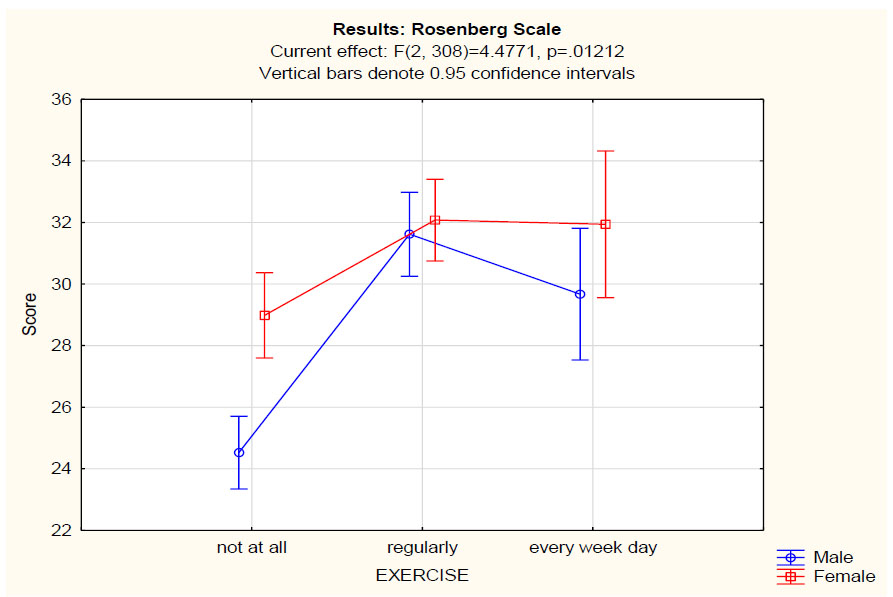All published articles of this journal are available on ScienceDirect.
The Association of Exercise and Self-Esteem among First-Year Students Registered at a Rural University In South Africa
Abstract
Introduction
Students who move from secondary school to tertiary institutions may experience stressors that lead to low self-esteem. This may, however, be alleviated by exercise. The aim of the study was to investigate the association of exercise with self-esteem among first-year students enrolled at a University in South Africa.
Methods
A cross-sectional survey design was used. The study sample consisted of 320 randomly selected first-year students, 160 students who exercised regularly and 160 students who did not exercise. Data was collected using the Rosenberg Self-Esteem Scale (RSE). The data were analysed using both non-inferential and inferential statistics.
Results
There were no statistically significant differences between the different ages and ethnicities with exercise and self-esteem. Exercisers had a slightly larger (14%) likelihood than non-participants of having more positive self-esteem, as shown by the OR of 1.14 (CI 1.06, 1.22).
Discussion: Men and women who exercised had higher self-esteem scores than those who did not exercise. Those who exercised had a higher likelihood of having a positive sense of self.
Conclusion
First-year university students should include exercise in their activities as this is related to higher self-esteem.
1. INTRODUCTION
Entering higher education is undoubtedly an exciting new adjustive experience, but for many first-year university students, it can also be a daunting, lonely and overwhelming journey [1]. Juggling the uncharted waters of academic demands with social adjustments and a new environment leaves these young students feeling confused and lonely, with very little sense of belonging [2]. As a consequence, they are vulnerable to psychological challenges, which can significantly impact their levels of self-esteem. Physical exercise offers an escape from these challenges [1]. Studies have shown the benefits of exercise on the physical and psychological well-being of first-year students, providing a promising avenue for enhancing their self-esteem and overall mental health. Female students seem to have better mental health benefits from exercising than male students [3].
Studies have shown that individuals who engage in regular exercise are likely to have positive health benefits over their entire lifespan. Exercise acts as a preventive measure against many mental illnesses. This is because positive endorphins are released during exercise, which augment an individual’s feelings of self-esteem [4, 5]. In our study, regular exercise refers to any physical exercise undertaken three times a week for thirty minutes or more over a period of two or more months. Non-regular exercise refers to students exercising less than this. Individuals who are mostly inactive have poor self-esteem, and those who do not engage in any exercise are more anxious and depressed. Many first-year university students struggle to cope with the academic demands and adjust to a new environment, which leads to poor levels of self-esteem. However, this can be alleviated by exercise [1]. The World Health Organisation (WHO) guidelines for physical exercise confirm the importance of physical exercise for good mental health [6, 7]. Universities should encourage students to prioritize exercise as a means of improving mental health. Studies have found a strong relationship between exercise and high levels of cognition and self-esteem. Low self-esteem is among the most important psychological factors affecting tertiary education students. Females who participated in exercise show a more optimistic psychological well-being as compared to males (p=0.001) [8]. However, it is important to note that there may be potential drawbacks to exercise among university students who may have contraindications to doing strenuous physical exercises. [4].
The change to university life is a significant milestone for young adults. This will be filled with new experiences, academic challenges, and the excitement of independence. However, the first year at university can also be overwhelming, as many first-year students grapple with their study demands and the adjustment to a novel environment [1]. One critical aspect that often goes unnoticed during this crucial phase is the students' sense of belonging, which has been found to be alarmingly low among many first-year university students [1]. This sense of belonging is improved with exercise, especially with group exercise [1]. This vulnerability to psychological distress can have detrimental effects on their self-esteem, impacting their overall well-being and academic performance [1]. These challenges have led to studies that explore potential solutions to enhance the mental well-being of first-year students. It has emerged from this research that physical exercise appears to play a key role in mitigating these issues and increasing self-esteem. Regular exercise ensures good psychological well-being, leading to higher levels of self-esteem and a healthier outlook on life for students [1, 8].
The relationship between stress, self-esteem, and exercise has not been studied extensively in South Africa. Therefore, the aim of this study was to investigate the association of exercise with self-esteem among first-year students registered at UNIVEN.
2. METHODS
2.1. Study Design
A cross-sectional design was used. The Rosenberg Self-Esteem Scale (RSES) was piloted prior to the study. In this cross-sectional study, all the STROBE guidelines of quality were covered.
2.2. Study Setting
The study was conducted at a previously dis- advantaged rural university in the Limpopo Province of South Africa. The majority of the students are under- privileged Black Africans. Students come to this university from rural areas of South Africa. There is little time for exercise or sport for these students as they have other pressing problems, such as walking long distances to school and uncertainty about meals.
2.3. Study Population, Sampling Technique, and Sample Size
All first-year undergraduate students who were registered at the UNIVEN for the 2019 academic year made up the study population. Information was obtained from the Office of the Registrar of UNIVEN. There were 1900 first-year students enrolled at the beginning of the 2019 academic year. The researchers took part in the orientation for first-year students, where researchers asked students who were interested in participating in the study to send their email addresses to the researchers. A list was drawn up of all respondents that agreed to participate. A total of 1300 email addresses (68.4% participation rate). The students' email addresses were used to send the questionnaire. Following that, the returned questionnaires were divided into two groups: those who regularly exercised and those who did not. Exercisers and non-exercisers were classified as follows: non-regular exercisers were those who did not engage in any physical activities, while exercisers were those who engaged in physical activity at least three times per week for about thirty minutes.
Using Morgan and Krejcie’s [9] table, a sample of 320 was representative of this population. To ensure that random sampling for the study could be properly constituted and to account for attrition, 300 exercisers and 300 non-exercisers were randomly identified from the email lists and questionnaires emailed to them. Random sampling was employed to enroll the sample of 320. In this regard, the lists of 300 exercisers and 300 non-exercisers were used. The final sample was 160 exercisers and 160 non-exercisers. Excluded students were those with a history of depression or anxiety disorders, less than 18 years of age, as well as those who were unable to exercise owing to physical, mental or medical conditions.
2.4. Data Collection
Data were collected over one month and were completed five weeks before the first COVID-19 lockdown in South Africa. The self-reporting questionnaire, Rosenberg Self-Esteem Scale (RSES), was the standardized tool that the researchers utilized. It consists of ten items that address self-respect, self-esteem, and self-acceptance. Its items are rated on a 4-point Likert scale. In essence, the scale evaluates self-esteem, and it captures how people feel about themselves in relation to others at a specific moment in time [10]. Some of the questions on the scale were: “On the whole, I am satisfied with myself,” and “I am able to do things as well as most other people.” The internal consistency (Cronbach alpha) has been measured in other studies to be 0.83 to 0.88, which is acceptable to good [11, 12]. Cronbach Alpha of .81 was found using a representative South African sample, which is good [13]. The Cronbach ɑ (internal consistency) for the RSES for the present study was calculated at 0. 81.
2.4.1. Pilot Study
To test the questionnaire, a pilot study of 30 respondents-sers and 15 non-exercisers-among the second-year students of the same university (UNIVEN) was carried out. The overall protocol's Cronbach alpha was 0.90. There were no problems reported regarding the questions. The questionnaire employed was a psychological test that has been standardized across time and a variety of populations [14].
2.5. Data Analysis
The study used descriptive and inferential statistics of the Analysis of Variance (ANOVA) and regression analysis to give a well-defined picture of the data. Inferential statistics were used to draw conclusions and/or to make predictions inherent to the population based on collected data [14, 15]. They are also used to investigate differences between and amongst groups. Descriptive statistics were used to give a general overview or picture of the data in numeric and graph format. Logistic regression analysis was used to establish whether age and gender influenced any outcomes.
3. RESULTS
3.1. Demographic Data
Regarding the distribution of participants by ethnicity, the majority of the first-year students were African (95%), followed by Coloured and Indian (2% each), and White (1%).
Fig. (1) below indicates the age distribution of the participants. Two hundred and eighty-eight participants (71%) were between the ages of 18-21 years, while 92 participants (29%) were between the ages of 22 and 29.
3.2. Gender distribution
Fig. (2) indicates that there were 160 participants who were male and 160 participants who were female, or 50% each.



3.3. Exercise Frequency
Fig. (3) indicates that 160 participants (50%) did not exercise at all, 120 participants (37%) exercised regularly, and 40 participants (13%) exercised every weekday.
3.4. The Rosenberg Self-esteem Scale (RSES)
Table 1 indicates in the first group that, 56 males in the 18–21-year age group did not exercise at all (Mean = 22.43; SD 7.37), while in the 22–29-year age group, 24 males did not exercise at all (Mean = 26.62; SD=5.21). In the 18–21-year age group, 65 females did not exercise at all (Mean = 29.83; SD4.34), while in the 22 – 29-year age group, 15 females did not exercise at all (M=28.13; SD = 5.88).
In the second group, thirty-four (34) males in the age group 18-21 years exercised regularly (Mean = 31.79; SD =3.12), while in the 22–29-year age group, 20 males exercised regularly (Mean = 31.45; SD= 3.73). Forty-four (44) females in the age group 18-21 years exercised regularly (Mean = 32.32; SD =4.29) while in the 22–29-year age group, 19 females exercised regularly (Mean = 31.8; SD= 3.50).
In the third group, nineteen (19) males in the age group 18-21 years exercised every weekday (M=29.63: SD= 4.27). In the 22–29-year age group, 7 males exercised every weekday (M=29.71: SD= 3.25). Ten (10) females in the age group 18-21 years exercised every weekday (M=32.60: SD =2.95). In the 22–29-year age group, 7 females exercised every weekday (M=31.29: SD= 3.45).
3.5. Demographic Information and Exercise
From Table 2, analysis of Variance (ANOVA) showed that there were main effects of Exercise Frequency: F (2, 308) = 30.73, p < 0.001, ηp2 = 0. 17 and of Gender: F (1, 308) = 11.63, p = 0.001, ηp2 = 0.04. There was an interacting effect of Exercise Frequency and Gender: F (2, 308) = 4.48, p = 0. 01,ηp2 = 0.03. An effect size (partially eta squared, ηp2) of 0.17 is considered as large, while those of 0.04 and 0.03 are considered as small. There was no effect of age, neither main nor interacting on the results for this scale; thus, only the gender groups were further analysed.
Post-hoc analysis (Bonferroni) revealed that the males who did not exercise at all had a significantly lower score on the RSES than the males who exercised regularly (p < 0.001).
The females who did not exercise at all scored significantly lower on the RSES than the females who exercised regularly (p = 0.02).
Fig. (4) represents a box plot depicting results for the inventory showing the current effect and confidence intervals. When the genders were compared, the males who did not exercise at all had significantly lower scores on the RSES than the females who did not exercise at all (p < 0.001).
| Exercise Frequency | Gender | Age Group | N | RSES Mean |
RSES SD |
|---|---|---|---|---|---|
| Not at all | Male | 18-21 | 56 | 22.43 | 7.37 |
| 22-29 | 24 | 26.63 | 5.21 | ||
| Female | 18-21 | 65 | 29.83 | 4.34 | |
| 22-29 | 15 | 28.13 | 5.88 | ||
| Regularly | Male | 18-21 | 34 | 31.79 | 3.12 |
| 22-29 | 20 | 31.45 | 3.73 | ||
| Female | 18-21 | 44 | 32.32 | 4.29 | |
| 22-29 | 19 | 31.84 | 3.50 | ||
| Every weekday | Male | 18-21 | 19 | 29.63 | 4.27 |
| 22-29 | 7 | 29.71 | 3.25 | ||
| Female | 18-21 | 10 | 32.60 | 2.95 | |
| 22-29 | 7 | 31.29 | 3.45 |
| - | DF | F | P | ηp2 |
|---|---|---|---|---|
| Exercise | 2, 308 | 30.73 | < 0.001*** | 0.17 |
| Gender | 1, 308 | 11.63 | 0.001** | 0.04 |
| Age | 1, 308 | 0.01 | 0.92 | 0.00 |
| Exercise x Gender | 2, 308 | 4.48 | 0.01* | 0.03 |
| Exercise x Age | 2, 308 | 0.96 | 0.39 | 0.01 |
| Gender x Age | 1, 308 | .11 | 0.08 | 0.01 |
| Exercise x Gender x Age | 2, 308 | 2.44 | 0.09 | 0.02 |

3.6. Logistic Regression Results for Self-esteem, for the Rosenberg Self-esteem Scale (RSES)
Results of a logistic regression analysis for the self-esteem RSES: Gender had a big impact on the measurement of self-esteem. The Odds ratio (OR) was 0.89 (CI 0.86, 093), and women had a marginally lower (11%) chance of developing a more favourable sense of self-esteem as a result of exercise than did men. Participating in the exercise had a good impact on one's self-esteem. Exercisers had a slightly larger (14%) likelihood than non-participants did of having more positive self-esteem, as shown by the OR of 1.14 (CI 1.06, 1.22). Age and ethnicity did not yield any statistically significant association (p = 0.34 and 0.32, respectively). The logistic regression analysis conforms results of the ANOVA analysis.
4. DISCUSSION
Exercise should be considered a lifestyle component associated with the health and well-being of students. In this study, we examined the association of exercise with self-esteem among first-year students at a rural university. Men who did not exercise at all scored significantly lower on the RSES than men who exercised regularly and men who exercised every day of the week (p < 0.001). Females who exercised infrequently or not at all scored considerably lower on the RSES than those who exercised regularly (p = 0.02). Exercise participation has a substantial association with the students’ sense of well-being. The group that exercised had a slightly higher (14%) likelihood than the non-exercise group to have a more positive sense of self, according to the OR of 1.14 (CI 1.06, 1.22).
Burke and Dempsey demonstrated that exercise promotes psychological or mental health by lowering anxiety, depression, and bad moods and by boosting self-esteem and cognitive abilities, which are consistent with these findings [16]. It has also been shown that exercise helps with symptoms including social disengagement and low self-esteem. It was shown in Iran an aerobic workout boosts self-esteem; and an increase in educational, family, social, and overall self-esteem levels were observed [17]. This is consistent with the findings from our study, which show a link between exercise and increased self-esteem. Additionally, it was claimed that treatments like mild to moderate physical activity performed four times per week for nine months improved the self-esteem of depressed people.
Students engaging in regular exercise displayed greater levels of self-assurance and overall life satisfaction in terms of social and academic advancement. They also reported fewer symptoms of anxiety and depression [18].
The current study's findings are consistent with those of national and international studies that revealed that exercise can help students feel less worried, more confident, and less depressed. These results led to the establishment of guidelines on physical activities or exercise for UNIVEN undergraduate students. The University of Venda (UNIVEN) ought to adopt a rule requiring undergraduate students to exercise. This should consider if the student is physically disabled, pregnant, or suffering from chronic conditions such as asthma. The value of exercise for general health and well-being should be discussed with students as early as during orientation and then reinforced in subsequent seminars/ platforms and webinars. Exercise specialists may contribute to this to improve the guidelines and/or run the exercise programs [19].
In order to improve students' physical and mental health as well as their general well-being, it is believed that UNIVEN will find these guidelines helpful as they explore including exercise in their student offerings.
5. LIMITATIONS
The study was carried out at a single rural university; thus, results may differ in other settings. A qualitative approach may have provided deeper insight into the reasons for students not exercising. Convenient sampling poses a threat to the representativeness of the sample. The cross-sectional design poses a threat to causal inference and internal validity. The construct validity is limited by the self-report measures, including recall bias and social desirability bias.
CONCLUSION
Gender, age, and ethnicity did not have a significant difference in self-esteem scores. The current study makes a substantial contribution to our understanding of the positive role exercise plays as an intervention in improving self-esteem among first-year university students who usually have to cope with adjustment difficulties and increased academic demands.
LIST OF ABBREVIATIONS
| OR | = Odds ratio |
| RSES | = Rosenberg Self-Esteem Scale |
| ANOVA | = Analysis of Variance |
| WHO | = World Health Organisation |
ETHICS APPROVAL AND CONSENT TO PARTICIPATE
This study was approved by the Institutional Ethical Committee of The University of Venda.
HUMAN AND ANIMAL RIGHTS
No animals were used in this research. All procedures performed in studies involving human participants were in accordance with the ethical standards of institutional and/or research committee and with the 1975 Declaration of Helsinki, as revised in 2013.
CONSENT FOR PUBLICATION
Written informed consent has been taken from the respondents for this study.
Anonymity and confidentiality were ensured during the entire study process.
AVAILABILITY OF DATA AND MATERIALS
All data have been obtained by the research process and is available afro the authors on request.
ACKNOWLEDGEMENTS
Part of this article has previously been published in "The impact of exercise on self-esteem, anxiety, and depression on first-year students at the University of Venda". Available at: http://ulspace.ul.ac.za/bitstream/han dle/10386/4237/tshikovhele_kl_2022.pdf?isAllowed=y&sequence=1 [19].


